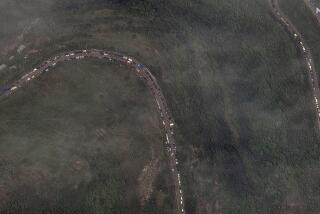COMMERCE : In Central Asia, a New Kind of Carpetbagger : Offering jobs (albeit low-paying ones) and skills, a weaver tries to revive lost art of the loom in economically ravaged former republics.
- Share via
SAMARKAND, Uzbekistan — An Oriental carpet mogul from Afghanistan and a caravan of 40 expert weavers have made their way through the breathtaking Pamir Mountains to try to revive the all-but-forgotten ancient craft in the former Soviet Central Asian republics.
Carpet weaving was a thriving home industry in many parts of Uzbekistan and Tajikistan before Soviet dictator Josef Stalin forced the nationalization of all industries and pushed the population into communal farms in the 1930s. Peasants could no longer get the yarn and dyes needed for their trade, women were forced to spend their time toiling in the cotton fields, and rug making all but died.
Now Mohamed Ewaz Badghisi, a 56-year-old entrepreneur who has taught tens of thousands of people in Afghanistan to weave traditional carpets with natural dyes, is setting up shop in Dushanbe, Tajikistan’s capital, and Samarkand, a large city in Uzbekistan that was a center of culture and commerce in the days of the ancient Silk Road.
“I want to teach these people, because these are the places where weaving originated,” Badghisi said.
His experts, who were glad to escape the violent unrest in their hometown of Kabul, spent six months in Dushanbe teaching about 25 local people.
“They are learning slowly,” 15-year-old Cobra Badghisi, a relative of Badghisi’s, said as she knelt on the floor and pulled threads of silk through a loom at lightning speed. “But they are getting the hang of it. Now we’ve left them there with looms to weave the carpets on their own, and they’ll do OK.”
She is one of the 40 weaving teachers Badghisi brought with him from Afghanistan. Most of the experts are relatives of his, and most are teen-agers and children.
Badghisi supplies his new students in the former Soviet republics with materials and looms and pays them 500 rubles per month, less than $4 at the current rate and about half the wage of a local janitor. Unemployment runs at close to 50% in these republics, so Badghisi has had no trouble finding people who are eager to learn a new craft, even at such a low wage.
He admits that it’s possible to bring carpet making to the former Soviet Central Asian republics only because labor is so inexpensive now. Carpets from Iran and Turkey, for instance, are pricing themselves out of the market because of higher labor costs.
The Badghisi clan has now moved on to Samarkand to set up production in this magnificent city of 15th-Century mosques.
Their next stop, Badghisi, said, is Bukhara, another city of the Silk Road, which all but sank into obscurity during the Soviet period. “Everyone who likes carpets knows what a Bukhara carpet is, but in Bukhara, no one makes carpets anymore,” Badghisi said. “I want to change that.”
Carpets in the Bukhara style were still made in some areas of Turkmenistan, another former Soviet Central Asian republic, during the Soviet period because the main occupation of people there was herding, which was not as time-consuming as raising cotton.
Another reason carpet weaving continued in Turkmenistan, scholars say, is that the carpets were already being made in small factories there. The Soviet state took over these factories and supported limited production.
But because all personal capital was liquidated in Uzbekistan and Tajikistan and the state did not support their craft, people could no longer afford to buy materials necessary for making carpets at home.
But the carpets now made in Turkmenistan, Badghisi insists, do not compare to the fantastic carpets made in the region before the Soviet period.
“They’ve lost the skill to make high-quality carpets and lost the ability to use natural dyes,” Badghisi said. “We will bring this all back.”
Badghisi held up an intricate carpet made by a master in Afghanistan. “This carpet pattern was designed more than 500 years ago here in Samarkand,” he said. “I hope that one day soon one of my students will be able to recreate this carpet here in Samarkand.”
More to Read
Sign up for Essential California
The most important California stories and recommendations in your inbox every morning.
You may occasionally receive promotional content from the Los Angeles Times.












